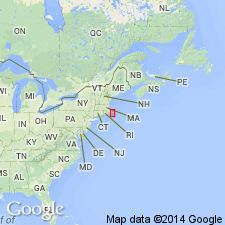
- Usage in publication:
-
- Greenleaf Mountain Formation
- Modifications:
-
- Not used
- AAPG geologic province:
-
- New England province
Summary:
Not used on MA State bedrock geologic map. [No explanation given. Still good usage.]
Source: GNU records (USGS DDS-6; Reston GNULEX).

- Usage in publication:
-
- Greenleaf Mountain Formation
- Modifications:
-
- Not used
- AAPG geologic province:
-
- New England province
Summary:
Rocks mapped as Greenleaf Formation by Bell and Alvord (1976) in Burlington, MA, area are included on MA State bedrock geologic map (Zen and others, 1983) in a Proterozoic Z unnamed unit of metamorphosed mafic to felsic flow, volcaniclastic, and hypabyssal intrusive rocks, which is part of a mafic assemblage of rocks. Assigned to mafic assemblage because of proximity to metavolcanic rocks previously mapped as Middlesex Fells Volcanic Complex, and because they contain biotite gneiss and amphibolite as major components. Report contains geologic maps and correlation charts. [Greenleaf Mountain Formation still good usage. Chapters A-J in U.S. Geological Survey Professional Paper 1366 are intended as explanations and (or) revisions to 1:250,000-scale MA State bedrock geologic map of Zen and others (1983).]
Source: GNU records (USGS DDS-6; Reston GNULEX).
For more information, please contact Nancy Stamm, Geologic Names Committee Secretary.
Asterisk (*) indicates published by U.S. Geological Survey authors.
"No current usage" (†) implies that a name has been abandoned or has fallen into disuse. Former usage and, if known, replacement name given in parentheses ( ).
Slash (/) indicates name conflicts with nomenclatural guidelines (CSN, 1933; ACSN, 1961, 1970; NACSN, 1983, 2005, 2021). May be explained within brackets ([ ]).

